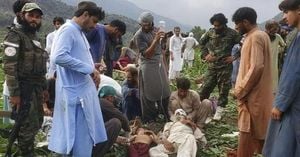The subtropical cyclone Biguá has brought destructive winds and heavy rainfall to the southern region of Brazil, particularly affecting the state of Rio Grande do Sul. Since its formation over the Atlantic Ocean, Biguá has created significant weather disturbances, leading to widespread power outages and structural damage.
On Sunday, December 15, winds gusting between 80 km/h and 100 km/h impacted several municipalities, leaving at least five cities struggling with power outages as reported by local energy providers. CEEE Equatorial indicated major disruptions, especially in Camaquã and Pelotas, where teams are actively working to restore electricity. The Regional Electricity Distributor (RGE) also reported outages affecting residents in the Valleys, Metropolitan, and Serra regions, but specifics of the affected customer counts remain unclear.
The cyclone's high winds didn’t just cause electrical issues; they resulted in serious incidents of structural damage as well. A notable example involved the roof of a sports facility collapsing during a children's event in Butiá, injuring both a man and teenager, with the latter requiring rescue from under debris. Reports of property damage have also emerged from other areas, including Triunfo, Encantado, and Pelotas, where fallen trees and roof damage have been documented.
According to the MetSul Meteorologia agency, Biguá is the first subtropical cyclone to impact the region since May 2022 and marks the first such event recorded during December. These cyclones differ from typical extratropical ones due to their formation processes and atmospheric conditions, which can lead to severe weather, including thunderstorms and heavy rainfall.
Various locations recorded significant wind speeds prior to the cyclone’s arrival on busy travel weekends. The Capão do Leão near Pelotas measured wind bursts of 81 km/h, with similar figures noted across the coastal and lowland areas of the southern state. For example, Rio Grande experienced 69 km/h gusts, and Jaguari, 62 km/h. These measurements reflect the potent nature of the cyclone, which had developed quickly and was expected to maintain intensity until late Sunday night before possibly weakening.
The Brazilian Navy, which monitors storm activity, is aware of the cyclone's capability to transition from its current subtropical status to potentially becoming a tropical depression as atmospheric conditions shift post-cyclone. The cyclone has sparked serious debates about climate variability and its impacts on Brazil's weather patterns.
Experts indicate the cyclone is unique due to its subtropical nature; it derives energy from both warm ocean waters and weather fronts, producing mixed effects compared to its extratropical counterparts. Melting heat from the Atlantic characters adds to the instability, creating vicious weather conditions. The cyclone's name, Biguá, is derived from the Tupi language, meaning marine bird, and it is the second cyclone to receive such naming under Brazil's new storm-naming guidelines.
Even as the cyclone passes over land, parts of Rio Grande do Sul are expected to face continued challenges, particularly with strong winds and heavy rains contributing to localized flooding and infrastructural strains. The municipal authorities have been mobilizing emergency resources to manage the adverse conditions effectively.
By Monday, December 16, the cyclone is forecasted to weaken, but officials warn residents to stay alert as squalls may still linger. The public has been advised extensively on weather safety measures, which include avoiding travel under trees or near unsafe structures and securing property to prevent damage from possible wind gusts.
Following the cyclone, local governments and emergency services will likely initiate recovery and rebuilding operations, focusing on restoring power and assessing the full extent of the damage. Schools and businesses may remain closed as cleanup efforts begin, with forecasts indicating some rainfall could persist, maintaining the risk of flooding.
The cyclone Biguá serves as yet another reminder of the need for preparation and awareness of climate-related hazards, especially as weather patterns evolve. With climate change making extreme weather increasingly common, residents are encouraged to remain informed and responsive to warnings issued by meteorological agencies.



